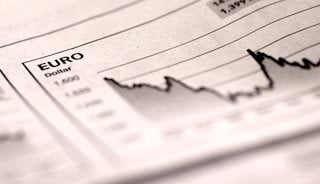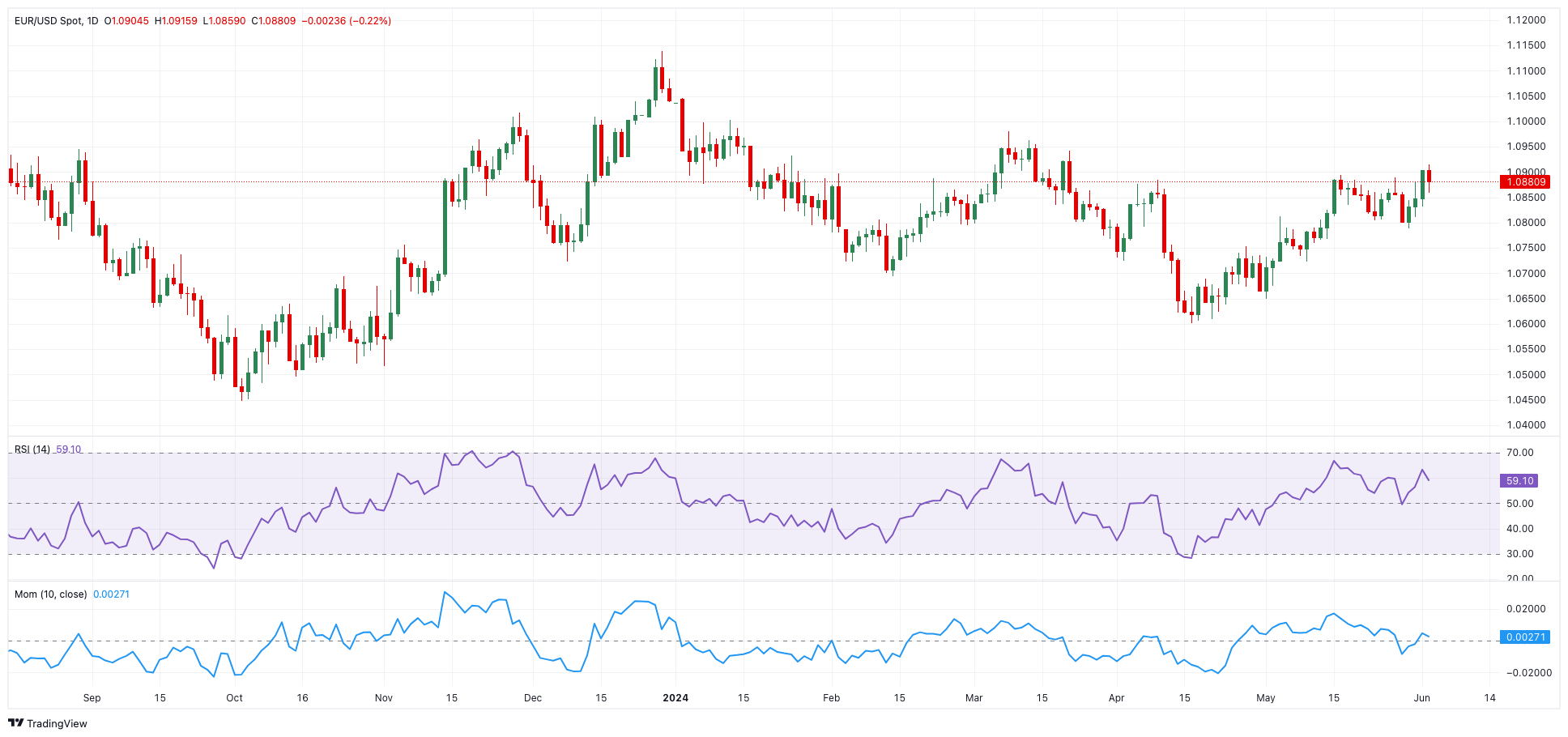EUR/USD Forecast: Immediately to the upside emerges 1.0980
Premium|
You have reached your limit of 5 free articles for this month.
Get all exclusive analysis, access our analysis and get Gold and signals alerts
Elevate your trading Journey.
UPGRADE- EUR/USD rose further and surpassed the 1.0900 barrier.
- The Greenback regained the smile and advanced slightly.
- The German labour market came in mixed in May.
The US Dollar (USD) traded marginally on the upside on Tuesday, putting the risk-related sector under some mild downside pressure and motivating EUR/USD to recede from earlier tops north of 1.0900 the figure, or multi-week tops.
The pair reversed three consecutive daily advances following the Greenback's fresh upward trend and the continuation of the decline in US yields across the board.
Meanwhile, recent hawkish statements from Fed officials have fueled speculation that the Federal Reserve (Fed) may retain its tight posture for a longer period of time than predicted. However, disheartening US JOLTs Job Opening prints appear to have underpinned an interest rate reduction in November.
Indeed, the CME Group's FedWatch Tool predicts a roughly 80% chance of lower interest rates by the November 7 meeting.
Despite stronger inflation estimates in Germany and the rest of the eurozone in May, the European Central Bank (ECB) is expected to decrease interest rates at its next meeting on June 6. Doubts remain, however, when it comes to considering prospective cutbacks after the summer.
Looking ahead, the Eurozone's incipient recovery in some economic fundamentals, together with the US economy's loss of momentum, reinforces the shrinking of the monetary policy difference between the Fed and the ECB, supporting a comeback in EUR/USD.
However, in the long run, given the increasing possibility that the ECB would cut rates before the Fed, additional EUR/USD depreciation should be expected in the coming months.
EUR/USD daily chart
EUR/USD short-term technical outlook
If bulls retain control, EUR/USD may test the June high of 1.0916 (June 4), then the March top of 1.0981 (March 8) and the weekly peak of 1.0998 (January 11), all before reaching the important 1.1000 level.
The resumption of the bearish tone, on the other hand, might push the pair below the weekly low of 1.0788 (May 30), which is supported by the 200-day SMA. The fall below this area might push the spot to the May low of 1.0649 (May 1), ahead of the 2024 bottom of 1.0601 (April 16) and the November 2023 low of 1.0516 (November 1). Once this zone is breached, the pair may head for the weekly low of 1.0495 (October 13, 2023) or the 2023 bottom of 1.0448 (October
So far, the 4-hour chart shows a small knee-jerk amidst the current upward bias. The 55-SMA at 1.0847 is the next downward barrier, followed by 1.0788 and 1.0781. On the upside, 1.0916 comes first ahead of 1.0942. The relative strength index (RSI) surged to around 56.
- EUR/USD rose further and surpassed the 1.0900 barrier.
- The Greenback regained the smile and advanced slightly.
- The German labour market came in mixed in May.
The US Dollar (USD) traded marginally on the upside on Tuesday, putting the risk-related sector under some mild downside pressure and motivating EUR/USD to recede from earlier tops north of 1.0900 the figure, or multi-week tops.
The pair reversed three consecutive daily advances following the Greenback's fresh upward trend and the continuation of the decline in US yields across the board.
Meanwhile, recent hawkish statements from Fed officials have fueled speculation that the Federal Reserve (Fed) may retain its tight posture for a longer period of time than predicted. However, disheartening US JOLTs Job Opening prints appear to have underpinned an interest rate reduction in November.
Indeed, the CME Group's FedWatch Tool predicts a roughly 80% chance of lower interest rates by the November 7 meeting.
Despite stronger inflation estimates in Germany and the rest of the eurozone in May, the European Central Bank (ECB) is expected to decrease interest rates at its next meeting on June 6. Doubts remain, however, when it comes to considering prospective cutbacks after the summer.
Looking ahead, the Eurozone's incipient recovery in some economic fundamentals, together with the US economy's loss of momentum, reinforces the shrinking of the monetary policy difference between the Fed and the ECB, supporting a comeback in EUR/USD.
However, in the long run, given the increasing possibility that the ECB would cut rates before the Fed, additional EUR/USD depreciation should be expected in the coming months.
EUR/USD daily chart
EUR/USD short-term technical outlook
If bulls retain control, EUR/USD may test the June high of 1.0916 (June 4), then the March top of 1.0981 (March 8) and the weekly peak of 1.0998 (January 11), all before reaching the important 1.1000 level.
The resumption of the bearish tone, on the other hand, might push the pair below the weekly low of 1.0788 (May 30), which is supported by the 200-day SMA. The fall below this area might push the spot to the May low of 1.0649 (May 1), ahead of the 2024 bottom of 1.0601 (April 16) and the November 2023 low of 1.0516 (November 1). Once this zone is breached, the pair may head for the weekly low of 1.0495 (October 13, 2023) or the 2023 bottom of 1.0448 (October
So far, the 4-hour chart shows a small knee-jerk amidst the current upward bias. The 55-SMA at 1.0847 is the next downward barrier, followed by 1.0788 and 1.0781. On the upside, 1.0916 comes first ahead of 1.0942. The relative strength index (RSI) surged to around 56.
Information on these pages contains forward-looking statements that involve risks and uncertainties. Markets and instruments profiled on this page are for informational purposes only and should not in any way come across as a recommendation to buy or sell in these assets. You should do your own thorough research before making any investment decisions. FXStreet does not in any way guarantee that this information is free from mistakes, errors, or material misstatements. It also does not guarantee that this information is of a timely nature. Investing in Open Markets involves a great deal of risk, including the loss of all or a portion of your investment, as well as emotional distress. All risks, losses and costs associated with investing, including total loss of principal, are your responsibility. The views and opinions expressed in this article are those of the authors and do not necessarily reflect the official policy or position of FXStreet nor its advertisers.
